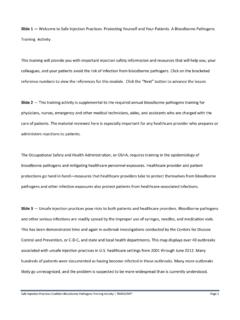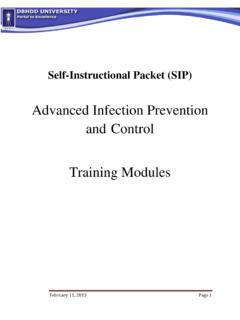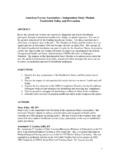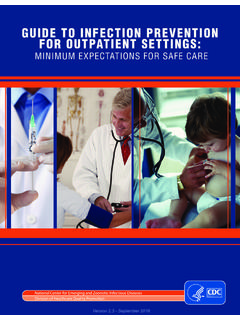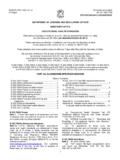Transcription of BLOODBORNE PATHOGEN EXPOSURE CONTROL …
1 The University of Arizona Tucson, Arizona BLOODBORNE PATHOGEN EXPOSURE CONTROL plan Reference 29 CFR BLOODBORNE pathogens November 1992 (Revised November 1995) (Revised December 1997) (Revised July 2001) (Revised August 2003) (Revised October 2007) (Revised June 2010) (Reviewed and Updated October 2011) (Reviewed and Updated July 2012) (Revised May 2014) (Revised August 2017) Questions regarding this plan may be directed to the Department of Risk Management and Safety at 621-1790. 2 TABLE OF CONTENTS The University of Arizona BLOODBORNE PATHOGEN EXPOSURE CONTROL Policy------- 3 Purpose ---------------------------------------- ---------------------------------------- ----------- 3 Scope and Application----------------------------- ---------------------------------------- --- 3 EXPOSURE Determination Definitions----------------------------- ---------------------------------------- ------------------ 4 Definition of " BLOODBORNE PATHOGEN " Definition of "blood" Definition of "other potentially infectious material" Responsibilities------------------------ ---------------------------------------- ----------------- 5 Managers
2 Supervisors Employees Risk Management and Safety Other Departments Employee's Rights---------------------------------- ---------------------------------------- ---- 7 Information and Training-------------------------------- ------------------------------------- 7 General EXPOSURE CONTROL Training Activity-Specific Information and Training Methods of Compliance------------------------------ ---------------------------------------- 8 Standard Precautions Personal Protective Equipment Engineering, Work Practices, and Housekeeping Labels and Signs HIV and HBV Research Laboratories and Production Facilities-------------------- 13 HIV and HBV Research Laboratories HIV and HBV Production Facilities Hepatitis B Vaccinations---------------------------- ---------------------------------------- 14 Emergency Procedures------------------------------ ---------------------------------------- - 14 Spills Occupational Exposures Post- EXPOSURE Evaluation and Follow-up------------------------------- ----------------- 15 Documentation of the Source Individual Collection and Testing of Exposed Individual's Blood Healthcare Professional s Written Opinion
3 Documentation and Recordkeeping--------------------------- ---------------------------- 16 Appendices A Standard Precautions for Healthcare Infection CONTROL B Biosafety in Microbiological and Biomedical Laboratories (BMBL) 5th Edition C University of Arizona Biohazardous/Pathological Waste Disposal Procedures D Hepatitis B Vaccine Declination Form E 29 CFR , BLOODBORNE pathogens Standard 3 THE UNIVERSITY OF ARIZONA BLOODBORNE PATHOGEN EXPOSURE CONTROL POLICY It is the policy of the University of Arizona to prevent employee infection from BLOODBORNE human pathogens in occupational settings at university facilities. PURPOSE To assist the university community with the implementation of this policy, the Department of Risk Management Services (RMS) administers a comprehensive program to implement those practices which safety and health experts have accepted as effective in minimizing the risks associated with BLOODBORNE pathogens .
4 The University of Arizona EXPOSURE CONTROL plan (ECP) characterizes individual responsibilities and sets forth uniform procedures addressing: standard precautions, information and training, labeling, waste disposal, and vaccinations, as required by Occupational Health and Safety Administration (OSHA) regulation 29 CFR , BLOODBORNE pathogens . This standard was promulgated to reduce workplace EXPOSURE to and transmission of human BLOODBORNE pathogens , especially the Human Immunodeficiency Virus (HIV), Hepatitis B virus (HBV), and Hepatitis C virus (HCV). SCOPE AND APPLICATION The following text is a written description of the University of Arizona's EXPOSURE CONTROL plan .
5 It is a procedural manual pertaining to infection CONTROL and biohazard safety at The University of Arizona. This plan is established to ensure compliance with paragraph (c) of the OSHA BLOODBORNE PATHOGEN standard (29 CFR ) and is based on the concept of universal or standard precautions. Employees who have a reasonably anticipated occupational EXPOSURE to BLOODBORNE pathogens must become knowledgeable in the applicable details of this plan and fulfill their responsibilities as outlined. This includes managerial and supervisory staff as well as those in the "at risk" categories mentioned below. All procedures that entail a reasonably anticipated EXPOSURE to human blood and/or other potentially infectious material must be planned and executed in accordance with the enclosed procedures.
6 All provisions of this plan become effective immediately. EXPOSURE Determination All of the employees at the University of Arizona in the following job classifications may have a reasonably anticipated occupational EXPOSURE to BLOODBORNE pathogens : Clinical Assistant Surgery Interviewer Research Nurse Forensic Anthropologist Anatomical Specialist Histology Technician Perfusionist Nurse Practitioner Nurse Licensed Practical Nurse 4 Senior Research Nurse Medical Technologist Phlebotomist Physician Chief Medical Technologist Medical Assistant Employee Wellness Coord. Physician Consultant Health Education Coord. Senior Medical Technologist Physical Therapist Assistant Physical Terapist Chief Athletic Trainer Assistant Athletic Trainer Student Athletic Trainer Junior Athletic Trainer Chief of Police Police Commander Police Lieutenant Police Sergeant Police Corporal Police Officer Plumber Lifeguard Some of the employees at the University of Arizona in the following job classifications may have a reasonably anticipated occupational EXPOSURE to BLOODBORNE pathogens .
7 Research Assistant Postdoctoral Fellow Research Specialist Associate Professor Research Technician Senior Research Associate Professor Graduate Research Assistant Research Associate Visiting Research Scientist Program Coordinator Research Assistant Professor Laboratory Assistant Graduate Assistant Senior Research Specialist Laboratory Technician Student Lab Assistant Ophthalmic Technician Postdoctoral Fellow Ophthalmic Photographer Graduate Teaching Assistant Ophthalmic Researcher Assistant Professor Clinical Pharmacist Graduate Student Custodian Research Aide Glassware Attendant Hazardous Waste Specialist Environmental Compliance Technician Mechanic Electrician Graduate Clinician Aerobics Instructor Aquatics Instructor Health Educator/Nutritionist Exercise Physiologist Biomedical Research Engineer Certain tasks performed by these employees may cause occupational EXPOSURE to human blood or body fluids.
8 Some of these tasks include patient-related examinations, blood-draws, diagnostic testing, research-related blood and tissue preparation, testing and culturing, waste handling and disposal, and emergency response. This list is not an all-inclusive list of employee job titles that may be 5 DEFINITIONS Definition of " BLOODBORNE PATHOGEN ": For the purposes of this plan , " BLOODBORNE PATHOGEN " means any pathogenic microorganisms that are present in human blood and can cause disease in humans. These pathogens include, but are not limited to, HBV, HCV, and HIV. Definition of "blood": For the purposes of this plan , "blood" means whole human blood, any of its parts (serum, platelets, etc.)
9 , products made from human blood, or any human body fluids contaminated with blood. Definition of "other potentially infectious material": For the purposes of this plan , "other potentially infectious material" means: The following human body fluids: semen, vaginal secretions, cerebrospinal fluid, synovial fluid, pleural fluid, pericardial fluid, peritoneal fluid, amniotic fluid, saliva in dental procedures, any body fluid that is visibly contaminated with blood, and all body fluids in situations where it is difficult to differentiate between body fluids; Any unfixed tissue or organ (other than intact skin) from a human (living or dead); HIV-containing cell or tissue cultures, organ cultures, and HIV- or HBV- or HCV-containing culture medium or other solutions, and; Blood, organs, or other tissues from experimental animals infected with HIV, HBV, or HCV, and; All human cell lines and tissue cultures RESPONSIBILITIES Responsibility for infection CONTROL rests at all levels, from the highest administrative level to the individual employee.
10 Managers: 6 All university managers including administrators, deans, department heads, and directors are responsible for: Ensuring that individuals under their management have the authority to implement the ECP, and; Ensuring that areas under their management are in compliance with the ECP. Supervisors: All supervisors, including principal investigators, instructors, and others having direct supervisory authority are responsible for maintaining a safe work environment that protects the employees under their supervision. This responsibility entails: Assuring that all employees under their immediate direction and CONTROL successfully complete BLOODBORNE PATHOGEN safety training provided by RMS; Recognizing the safety and health hazards to which these employees may be exposed; Acquiring, and/or developing and implementing appropriate EXPOSURE controls; Providing activity-specific training and information to employees on these exposures and the methods used to CONTROL these exposures; Verify that all employees know and follow the work practices and procedures specified in the ECP.

